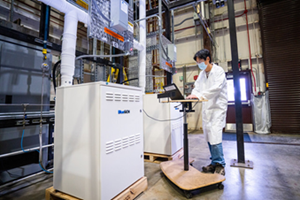News
NETL demonstrates fuel cell stack cost, performance and durability
NETL is demonstrating how solid oxide fuel cell (SOFC) stacks are uniquely suited to address environmental concerns associated with electric power generation while meeting clean energy goals with installation of four 1.5-KW SOFC stacks at its Morgantown site to supply 5.6 KW of power to the facility’s grid.
According to the U.S. Department of Energy (DOE) Office of Fossil Energy Carbon Management, “Fuel cells are an energy user's dream: an efficient, combustion-less, virtually pollution-free power source, capable of being sited in downtown urban areas or in remote regions that runs almost silently and has few moving parts.”
NETL’s Harry Abernathy explained that SOFCs produce electricity through electrochemical reactions, like a battery, rather than through combustion, like conventional coal and natural gas power plants, which makes fuel cells much more efficient and environmentally benign. Those benefits make the technology well-suited to helping meet clean energy goals that call for a net-zero carbon emission electricity sector by 2035 and economy-wide net-zero emissions by 2050.
According to DOE’s Office of Energy Efficiency and Renewable Energy, “The fuel cell stack is the heart of a fuel cell power system. It generates electricity in the form of direct current (DC) from electrochemical reactions that take place in the fuel cell. A single fuel cell produces less than 1 V, which is insufficient for most applications. Therefore, individual fuel cells are typically combined in series into a fuel cell stack. A typical fuel cell stack may consist of hundreds of fuel cells. The amount of power produced by a fuel cell depends upon several factors, such as fuel cell type, cell size, the temperature at which it operates, and the pressure of the gases supplied to the cell.”
Abernathy said the operation of the four 1.5-kW stacks at NETL Morgantown represents the first stage in the multi-year collaborative project.
“The stacks were purchased by NETL as part of a collaborative SOFC Program project with Aris Renewable Energy aimed at demonstrating fuel cell resiliency and applications in small-scale commercial markets,” Abernathy said. “Aris Renewable Energy is the American distributor for SolydEra, a European SOFC manufacturer.”
The knowledge gained from the stack tests will set the stage for more and larger deployments by addressing scalability potential of the SOFC stacks. The three-year project plan calls for installation of 27-kW SOFC stacks at a NASA facility in Fairmont, West Virginia, and installation of a newer 1.5-kW stack model at NETL in Morgantown. The newer stack model at Morgantown will be stress-tested under dynamic loading conditions to match the varying electrical demands placed on a small-scale installation.
DOE is working closely with its national laboratories, universities and industry partners to overcome critical technical barriers to fuel cell development. Researchers are focusing on demonstrating capabilities in three key areas that remain challenging for the fuel cell industry. Those areas are:
- Cost — Research focuses on the development of low-cost fuel cell stacks, plant components and advanced high-volume manufacturing approaches to reduce overall system cost.
- Performance — Investigations to improve fuel cell efficiency and performance that focus on innovative materials and integration strategies.
- Durability — Because fuel cell applications generally require adequate performance to be maintained over long periods of time, DOE has set targets for fuel cell system lifetime under realistic operating conditions. Research focuses on identifying and understanding fuel cell degradation mechanisms and developing materials and strategies to mitigate their effects.


